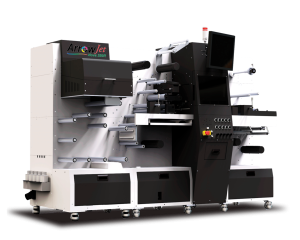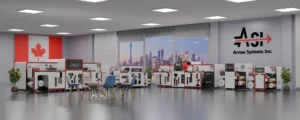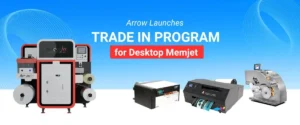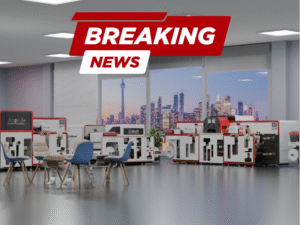Table of Contents
Pharmaceutical Packaging: How Digital Offers Solutions
The pharmaceutical industry is highly regulated and competitive. Pharmaceutical packaging can play a crucial role in ensuring product safety, compliance, and brand integrity.
However, pharmaceutical companies often face numerous challenges and pain points for their packaging. These can range from regulatory requirements to supply chain complexities.
We’ll explore some common pharma packaging pain points and how digital printing can offer innovative solutions to address them.
Arrow Systems, Inc. offers a wide range of water-based pigment inkjet solutions geared towards pharmaceutical packaging. Some of the common challenges pharmaceutical companies face when it comes to printing their own packaging are:
Overcoming Regulatory Hurdles with Digital Printing
Stringent Regulatory Compliance: One of the most significant pain points for pharmaceutical companies is navigating the complex web of regulatory requirements. Pharmaceutical products must adhere to strict regulations governing packaging materials, labeling, and printing.
Non-compliance can result in severe consequences, including fines, product recalls, and damage to brand reputation. Digital printing for pharmaceutical labels offers the flexibility to quickly adapt to changing regulations and produce compliant packaging.
Customization Made Easy: Digital Printing for Flexibility
Limited Flexibility and Customization: Traditional printing methods often lack the flexibility to accommodate short print runs, variable data printing, and on-demand packaging needs.
Digital printing technology allows pharmaceutical companies to overcome these limitations by enabling customization and personalization of packaging materials on the fly.
Digital printing offers unparalleled flexibility to meet the diverse needs of the pharmaceutical industry. Whether it’s printing unique serial numbers, barcodes, or patient-specific information, digital solutions help to simplify the process.
Securing Your Brand and Products: Digital Solutions for Authentication
Counterfeit Prevention and Product Authentication: Counterfeit pharmaceuticals pose a significant threat to public health and safety. Ensuring product authenticity and traceability is more critical than ever.
Anti-counterfeiting features, track-and-trace capabilities, serialization, and specialized materials can provide pharmaceutical companies with the tools they need to combat counterfeiters effectively.
By incorporating security features like holographic elements, QR codes, and tamper-evident seals, digital printing helps protect consumers and safeguard brand reputation.
Streamlining the Supply Chain: Digital Printing for Efficiency
Supply Chain Efficiency and Just-in-Time Manufacturing: In today’s fast-paced business environment, pharmaceutical companies are under increasing pressure to optimize their supply chains and minimize inventory costs.
Digital printing technology supports just-in-time manufacturing and lean inventory management by reducing lead times and enabling on-demand production of packaging materials.
Eliminating the need for large print runs and excessive inventory is one of the key benefits to digital printing. Bringing the printing in-house can streamline the supply chain and improve operational efficiency.
Maintaining Brand Identity: Digital Printing for Consistency
Brand Consistency and Innovation: Maintaining brand consistency across a diverse portfolio of products and packaging formats can be challenging for pharmaceutical companies.
Digital printing offers unmatched color consistency and print quality, ensuring that brand logos, colors, and messaging remain consistent across all packaging materials.
Additionally, digital printing enables pharmaceutical companies to innovate with unique packaging designs, textures, and finishes, enhancing product differentiation and consumer engagement.
The Future of Pharma Packaging is Digital
Pharmaceutical companies seeking to overcome packaging pain points and achieve greater efficiency, compliance, and innovation turn to digital printing.
Digital printing allows a streamlined approach for the healthcare industry. It decreases the reliance on packaging companies and takes some of the external factors out of the supply chain.
By embracing digital printing solutions, pharmaceutical companies can address regulatory challenges, enhance supply chain visibility, and protect their products from counterfeiting.
As the industry continues to evolve, investing in digital printing capabilities is not just a competitive advantage; it’s a strategic imperative. Pharmaceutical companies looking to thrive in the digital age need to look no further than Arrow Systems, Inc.
Arrow has developed a range of digital printing solutions for the pharmaceutical packaging market. Arrow equipment produces primary, secondary, and tertiary packaging for pharmaceutical products.
Arrow equipment produces all different types of pharmaceutical packaging. Child resistant packaging, blister foil for blister packs, labels, and flexible packaging for medical devices.
The innovative water-based pigment inks can print on a range of materials for pharmaceutical types of packaging.
The technology is already changing the pharmaceutical packaging industry by allowing customers to print as needed. No need to hold high minimum order quantities for pre-cut labels. The ArrowJet Nova 250R allows customers to print and cut on demand, streamlining the workflow.

The innovative design allows customers to digitally print any image and cut it to any size or shape. The inline 125W laser cutter can cut through almost any material with ease. This provides a streamlined approach for pharmaceutical companies looking to reduce inventory and increase throughput.
The ArrowJet Aqua series is a standalone printer with a variety of options. It can print labels, flexible packaging, blister foil, shrink sleeve, and many other materials commonly used for packaging.
FAQs
Q: What are the biggest challenges facing pharmaceutical packaging?
A: Pharmaceutical companies grapple with strict regulations, limited customization options, and the need to combat counterfeiting. Traditional printing methods often struggle to address these challenges effectively.
Q: How can digital printing help overcome these challenges?
A: Digital printing offers several advantages:
- Regulatory Compliance: Digital printing allows for quick adaptation to changing regulations, ensuring your packaging remains compliant.
- Enhanced Flexibility: Customize and personalize packaging materials on-demand for short print runs and variable data printing.
- Counterfeit Prevention: Integrate security features like QR codes and tamper-evident seals to combat counterfeiting and protect your brand.
Q: What are the benefits of water-based inks for pharmaceutical packaging?
A: Water-based inks are a safer and more sustainable alternative to traditional solvent-based inks. They offer:
- Safety: Reduced VOC emissions minimize risks for workers and consumers.
- Sustainability: Lower environmental impact compared to solvent-based inks.
- Non-toxic and Odorless: Enhance the overall safety and appeal of the packaging.
Q: Can digital printing handle different types of pharmaceutical packaging?
A: Arrow Systems’ digital printing solutions are versatile and can print on a variety of materials used in pharmaceutical packaging, including:
- Labels
- Blister foil
- Child-resistant packaging
- Flexible packaging for medical devices
- Shrink sleeves
Q: How does digital printing improve supply chain efficiency?
A: Digital printing enables just-in-time manufacturing, eliminating the need for large print runs and excessive inventory storage. This reduces lead times and streamlines your supply chain.
Q: Is digital printing a good investment for pharmaceutical companies?
A: Digital printing offers numerous advantages for pharmaceutical companies, including:
- Increased efficiency and compliance
- Enhanced brand protection
- Reduced costs through on-demand printing
- Improved agility to meet market demands
Contact With Our Team Now

Breaking News: Arrow Systems Partners with BUSINESSWARE to Transform Digital Printing Across Greece & Cyprus

Sid Sistemas de Impresión in Spain Installs ArrowJet Aqua 330R and DPR Taurus to Bolster Label Production

Step Inside Innovation: Arrow Systems New Experience Center Opens in Ontario, Canada.


